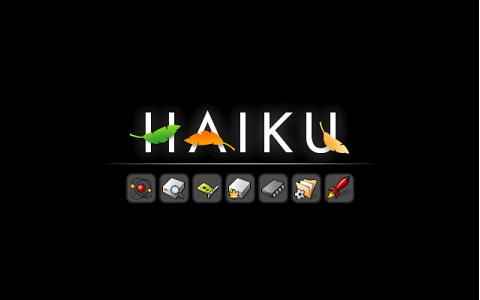Zavádzač systému
Zavádzač systému Haiku vám môže pomôcť, keď narazíte na problémy s hardvérom alebo ak si chcete vybrať, ktorú inštaláciu Haiku chcete spustiť ak máte viac než jednu (možno na inštalačnom CD alebo na kľúči USB).
Tiež sa hodí potom ako nainštalujete softvérový komponent, ktorý robí problémy a zabraňuje vám naštartovať systém, na jeho odstránenie a opätovné pridanie. Voľba Vypnúť používateľské doplnky, ktorá sa spomína nižšie spustí Haiku bez načítania komponentov, ktoré nainštaloval používateľ, napr. ovládače zariadení.
Voľby Zavádzača systému môžete zadať po stlačení a podržaní klávesu SHIFT pred začiatkom zavádzania systému Haiku. Ak je nainštalovaný správca zavádzania, môžete kláves SHIFT začať držať už predtým, než vyvoláte položku Haiku. Ak je Haiku na počítači jediný operačný systém, môžete začať držať kláves ešte vtedy, keď vidíte štartovacie správy od BIOSu.
 Boot Loader Options
Boot Loader Options
Po jeho zobrazení vám ponúkne štyri menu:
| Vyberte zavádzací zväzok | Vyberte, ktorú inštaláciu Haiku chcete spustiť. | |
| Select safe mode options | There are several options to try in case of hardware related trouble or if the system becomes unstable or unbootable because of a misbehaving add-on. When moving the selection bar to an option, a short explanation appears at the bottom of the screen. | |
|
| ||
| Select debug options | Here you'll find several options that help with debugging or getting details for a bug report. Again, a short explanation for each option is displayed at the bottom. | |
|
| ||
| If "Enable debug syslog" is activated, a warm reboot after a crash shows these additional options: | ||
|
| ||
| Vyberte bezpečný grafický režim | Ak ste museli aktivovať voľbu Použiť bezpečný grafický režim, tu môžete nastaviť rozlíšenie a farebnú hĺbku. |
 Troubleshooting
Troubleshooting
If Haiku refuses to boot on your hardware from the get-go, try out setting different options under . Consider filing a bug report in any case.
On the other hand, if Haiku only suddenly acts up after you have installed some software, especially hardware drivers, you have several options to get Haiku bootable again to make things right by uninstalling the offending package again:
Activating will prevent most servers, daemons and the UserBootScript from being started.
Activating will prevent using any add-ons (drivers, translators, etc.) you have installed in the user hierarchy under your Home folder.
If the offending driver, add-on etc. is installed in the system hierarchy, things get a bit more complicated, because that area is read-only. Here, the comes into play. With it, you can navigate through the whole system hierarchy and disable the component that's messing things up for you by checking an entry with the SPACE or RETURN key. ESC returns you up one level to the parent directory.
Online, there's the article How to Permanently Blacklist a Package File showing how to make that setting stick.
 Booting Haiku
Booting Haiku
Po aktivovaní jednej alebo viacerých volieb sa vrátite do hlavného menu a môžete pokračovať v zavádzaní systému, ktoré sa nachádza na tejto obrazovke:

Ak všetko funguje, postupne sa rozsvecuje jeden symbol za druhým.
Rozličné symboly zhruba zodpovedajú týmto fázam zavádzania:
| Atóm | Inicializácia modulov. | |
| Disk + lupa | Vytvára sa rootfs (/) a pripája sa devfs (/dev). | |
| Zásuvná karta | Inicializuje sa správca zariadení. | |
| Zavádzací disk | Pripája sa zavádzací disk. | |
| Čip | Načítavajú sa moduly špecifické pre CPU. | |
| Priečinok | Konečná inicializácia subsystémov. | |
| Raketa | Zavádzací skript spúšťa systém. |
 Slovenčina
Slovenčina Français
Français Deutsch
Deutsch Italiano
Italiano Русский
Русский Español
Español Svenska
Svenska 日本語
日本語 Українська
Українська 中文 [中文]
中文 [中文] Português
Português Suomi
Suomi Magyar
Magyar Português (Brazil)
Português (Brazil) Català
Català Polski
Polski English
English